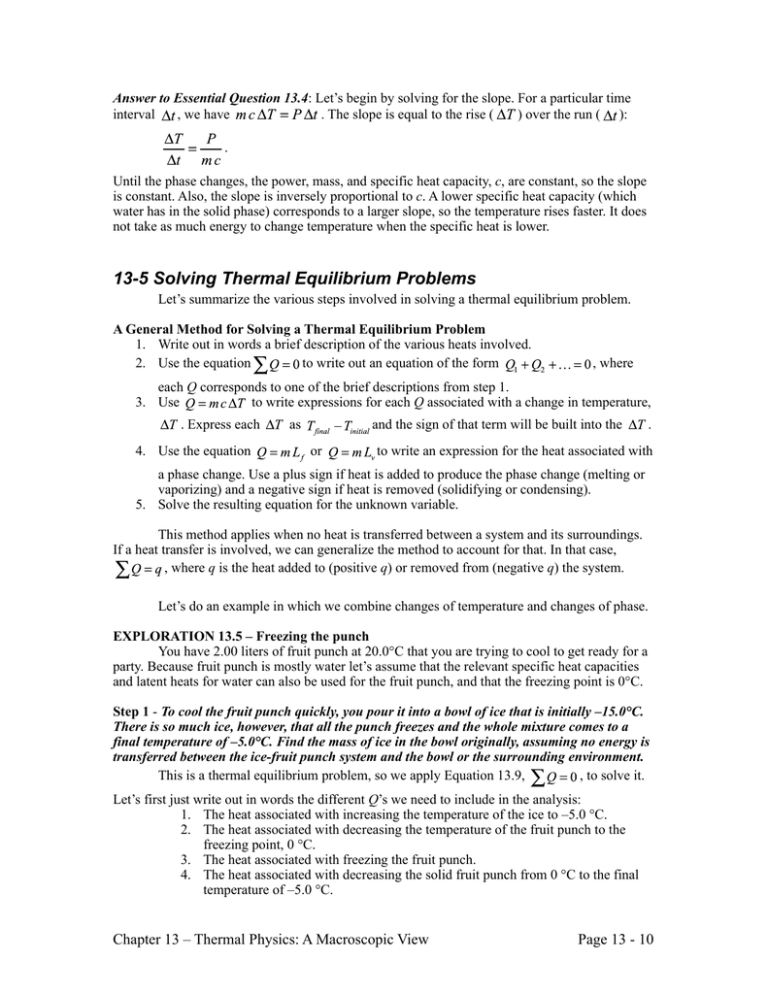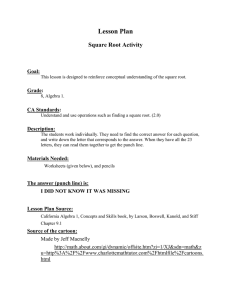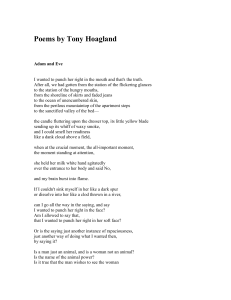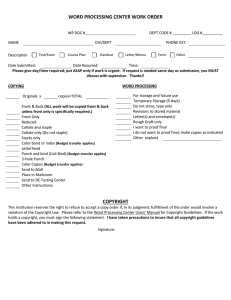13-5 Solving Thermal Equilibrium Problems
advertisement

Answer to Essential Question 13.4: Let’s begin by solving for the slope. For a particular time interval , we have . The slope is equal to the rise ( ) over the run ( ): . Until the phase changes, the power, mass, and specific heat capacity, c, are constant, so the slope is constant. Also, the slope is inversely proportional to c. A lower specific heat capacity (which water has in the solid phase) corresponds to a larger slope, so the temperature rises faster. It does not take as much energy to change temperature when the specific heat is lower. 13-5 Solving Thermal Equilibrium Problems Let’s summarize the various steps involved in solving a thermal equilibrium problem. A General Method for Solving a Thermal Equilibrium Problem 1. Write out in words a brief description of the various heats involved. 2. Use the equation to write out an equation of the form , where each Q corresponds to one of the brief descriptions from step 1. 3. Use to write expressions for each Q associated with a change in temperature, . Express each 4. Use the equation as and the sign of that term will be built into the or . to write an expression for the heat associated with a phase change. Use a plus sign if heat is added to produce the phase change (melting or vaporizing) and a negative sign if heat is removed (solidifying or condensing). 5. Solve the resulting equation for the unknown variable. This method applies when no heat is transferred between a system and its surroundings. If a heat transfer is involved, we can generalize the method to account for that. In that case, , where q is the heat added to (positive q) or removed from (negative q) the system. Let’s do an example in which we combine changes of temperature and changes of phase. EXPLORATION 13.5 – Freezing the punch You have 2.00 liters of fruit punch at 20.0°C that you are trying to cool to get ready for a party. Because fruit punch is mostly water let’s assume that the relevant specific heat capacities and latent heats for water can also be used for the fruit punch, and that the freezing point is 0°C. Step 1 - To cool the fruit punch quickly, you pour it into a bowl of ice that is initially –15.0°C. There is so much ice, however, that all the punch freezes and the whole mixture comes to a final temperature of –5.0°C. Find the mass of ice in the bowl originally, assuming no energy is transferred between the ice-fruit punch system and the bowl or the surrounding environment. This is a thermal equilibrium problem, so we apply Equation 13.9, , to solve it. Let’s first just write out in words the different Q’s we need to include in the analysis: 1. The heat associated with increasing the temperature of the ice to –5.0 °C. 2. The heat associated with decreasing the temperature of the fruit punch to the freezing point, 0 °C. 3. The heat associated with freezing the fruit punch. 4. The heat associated with decreasing the solid fruit punch from 0 °C to the final temperature of –5.0 °C. Chapter 13 – Thermal Physics: A Macroscopic View Page 13 - 10 Let’s use to represent the mass of the ice, and to represent the mass of the fruit punch. Use the information given in the problem to determine the mass of the fruit punch, assuming again that fruit punch is basically water. Water’s density is such that 1 ml of water has a mass of 1 g. With 2.00 liters of punch we have 2000 ml, which is = 2000 g = 2.00 kg. Setting up the equation gives: ; . In the last term, we use the specific heat capacity for solid water, because that term is the heat required to bring the solid punch from the freezing point to the final temperature of –5°C. When using the signs on the terms come naturally from the relationship . The sign on a heat associated with a phase change, however, needs to be put in explicitly. In this case the fruit punch is solidifying, so heat is removed from the punch. This is why the term has a negative sign. Solving the equation for the mass of the ice gives: . 2.00 kg "#(4186 J / kg °C)(20°C) + (3.33 ! 10 5 J/kg) + (2060 J / kg °C)(5°C) $% = 41.5 kg. (2060 J / kg °C)(10°C) The fact that the mass required is so large reflects the fact that it takes a great deal of energy to freeze the punch. mi = Step 2 - Because nobody can drink the solid fruit punch, you start again with a new 2.00-liter batch of punch at 20.0°C. Calculate the mass of ice, at –15.0°C, you should add to the punch so that the final temperature is 0°C and all the ice melts. This time we need three terms in the heat equation. They are: 1. The heat to increase the temperature of the ice to the melting point, 0°C. 2. The heat needed to melt all the ice at 0°C. 3. The heat associated with decreasing the temperature of the fruit punch to 0°C. Write out these terms in the analysis to solve for , the new mass of the ice: ; . Note that the term involving the phase change is positive, because heat is added to the ice to cause it to melt. Solving for the mass of ice this time gives: . This is a more reasonable amount of ice than the more than 20 kg we found in step 1! Key idea for solving thermal equilibrium problems: The method can be used in cases involving changes of phase. Related End-of-Chapter Exercises: Exercises 43 – 45. Essential Question 13.5: Return to step 2 of Exploration 13.5. Is 0.447 kg of ice the only mass of ice that gives a final temperature of 0°C? Explain your answer qualitatively. Chapter 13 – Thermal Physics: A Macroscopic View Page 13 - 11




